Table of Contents
ToggleClass 10 maths 5.3 solutions
NCERT Solutions For Class 10 Maths Chapter 5 Arithmetic Progressions Ex 5.3
Download the free NCERT Maths Chapter 5 Solutions for Class 10 here Arithmetic Progressions in Maths Class 10 NCERT Solutions are a great resource for homework assistance. For class 10 maths 5.3 ncert solutions Expert Bhautikstudy.com Teachers developed the NCERT Solutions. Complete solutions to all the problems in NCERT Textbook’s Chapter 5 Math Class 10 Pair of Linear Equations in Two Variables Exercise 5.3.
Class 10 Maths 5.3 NCERT Solutions Question 1.
1. Find the sum of the following APs.
(i) 2, 7, 12 ,…., to 10 terms.
(ii) − 37, − 33, − 29 ,…, to 12 terms
(iii) 0.6, 1.7, 2.8 ,…….., to 100 terms
(iv) 1/15, 1/12, 1/10, …… , to 11 terms
Solution:

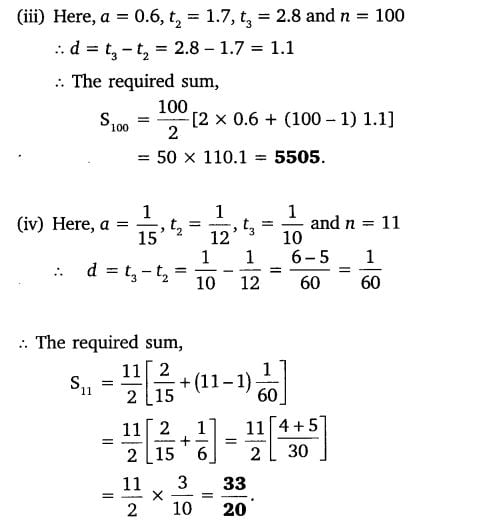
Class 10 Maths 5.3 NCERT Solutions Question 2.
2. Find the sums given below:
![]() (ii) 34 + 32 + 30 + ……….. + 10
(ii) 34 + 32 + 30 + ……….. + 10
(iii) − 5 + (− 8) + (− 11) + ………… + (− 230)
Solution:


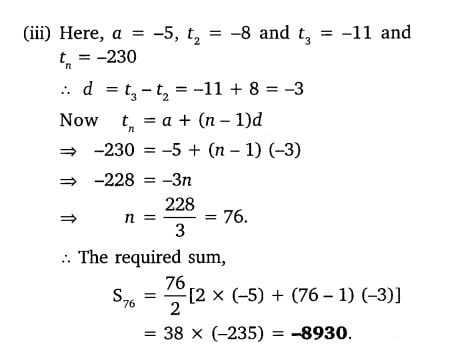
Class 10 Maths 5.3 NCERT Solutions Question 3.
3. In an AP
(i) Given a = 5, d = 3, an = 50, find n and Sn.
(ii) Given a = 7, a13 = 35, find d and S13.
(iii) Given a12 = 37, d = 3, find a and S12.
(iv) Given a3 = 15, S10 = 125, find d and a10.
(v) Given d = 5, S9 = 75, find a and a9.
(vi) Given a = 2, d = 8, Sn = 90, find n and an.
(vii) Given a = 8, an = 62, Sn = 210, find n and d.
(viii) Given an = 4, d = 2, Sn = − 14, find n and a.
(ix) Given a = 3, n = 8, S = 192, find d.
(x) Given l = 28, S = 144 and there are total 9 terms. Find a.
Solution:







Class 10 Maths 5.3 NCERT Solutions Question 4.
4. How many terms of the AP. 9, 17, 25 … must be taken to give a sum of 636?
Solution:

Class 10 Maths 5.3 NCERT Solutions Question 5.
5. The first term of an AP is 5, the last term is 45 and the sum is 400. Find the number of terms and the common difference.
Solution:
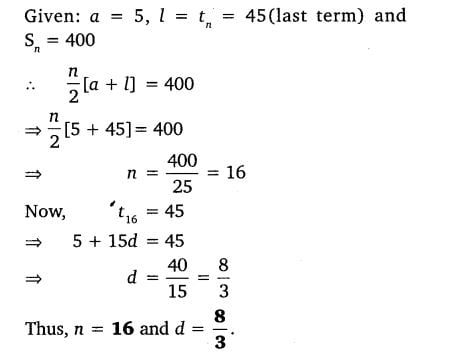
Class 10 Maths 5.3 NCERT Solutions Question 6.
6. The first and the last term of an AP are 17 and 350 respectively. If the common difference is 9, how many terms are there and what is their sum?
Solution:
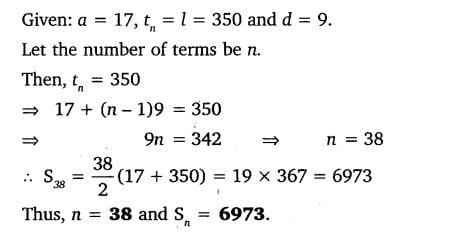
Class 10 Maths 5.3 NCERT Solutions Question 7.
7. Find the sum of first 22 terms of an AP in which d = 7 and 22nd term is 149.
Solution:

Class 10 Maths 5.3 NCERT Solutions Question 8.
8. Find the sum of first 51 terms of an AP whose second and third terms are 14 and 18 respectively.
Solution:
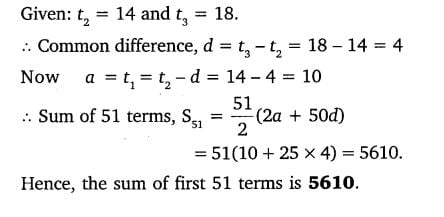
Class 10 Maths 5.3 NCERT Solutions Question 9.
9. If the sum of first 7 terms of an AP is 49 and that of 17 terms is 289, find the sum of first n terms.
Solution:

Class 10 Maths 5.3 NCERT Solutions Question 10.
10. Show that a1, a2 … , an , … form an AP where an is defined as below
(i) an = 3+4n
(ii) an = 9−5n
Also find the sum of the first 15 terms in each case.
Solution:


Class 10 Maths 5.3 NCERT Solutions Question 11.
11. If the sum of the first n terms of an AP is 4n − n2, what is the first term (that is S1)? What is the sum of first two terms? What is the second term? Similarly find the 3rd, the10th and the nth terms.
Solution:

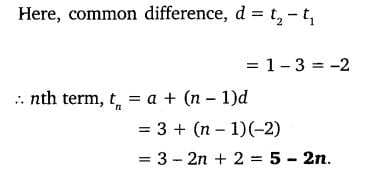
Class 10 Maths 5.3 NCERT Solutions Question 12.
12. Find the sum of first 40 positive integers divisible by 6.
Solution:
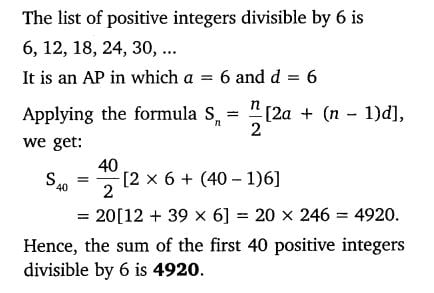
Class 10 Maths 5.3 NCERT Solutions Question 13.
13. Find the sum of first 15 multiples of 8.
Solution:
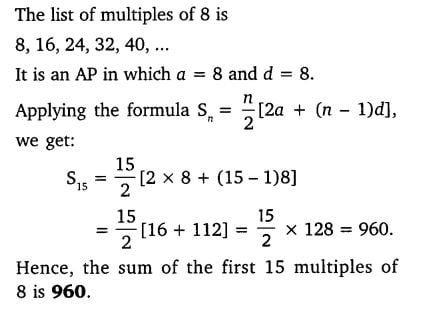
Class 10 Maths 5.3 NCERT Solutions Question 14.
14. Find the sum of the odd numbers between 0 and 50.
Solution:

Class 10 Maths 5.3 NCERT Solutions Question 15.
15. A contract on construction job specifies a penalty for delay of completion beyond a certain date as follows: Rs. 200 for the first day, Rs. 250 for the second day, Rs. 300 for the third day, etc., the penalty for each succeeding day being Rs. 50 more than for the preceding day. How much money the contractor has to pay as penalty, if he has delayed the work by 30 days.
Solution:

Class 10 Maths 5.3 NCERT Solutions Question 16.
16. A sum of Rs 700 is to be used to give seven cash prizes to students of a school for their overall academic performance. If each prize is Rs 20 less than its preceding prize, find the value of each of the prizes.
Solution:

Class 10 Maths 5.3 NCERT Solutions Question 17.
17. In a school, students thought of planting trees in and around the school to reduce air pollution. It was decided that the number of trees, that each section of each class will plant, will be the same as the class, in which they are studying, e.g., a section of class I will plant 1 tree, a section of class II will plant 2 trees and so on till class XII. There are three sections of each class. How many trees will be planted by the students?
Solution:

Class 10 Maths 5.3 NCERT Solutions Question 18.
18. A spiral is made up of successive semicircles, with centres alternately at A and B, starting with centre at A of radii 0.5, 1.0 cm, 1.5 cm, 2.0 cm, ……… as shown in figure. What is the total length of such a spiral made up of thirteen consecutive semicircles? (Take π = 22/7)
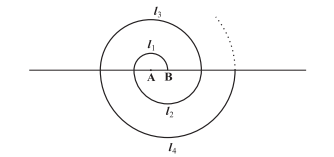
Solution:

Class 10 Maths 5.3 NCERT Solutions Question 19.
19. 200 logs are stacked in the following manner: 20 logs in the bottom row, 19 in the next row, 18 in the row next to it and so on. In how many rows are the 200 logs placed and how many logs are in the top row?

Solution:


Class 10 Maths 5.3 NCERT Solutions Question 20.
20. In a potato race, a bucket is placed at the starting point, which is 5 m from the first potato and other potatoes are placed 3 m apart in a straight line. There are ten potatoes in the line.

A competitor starts from the bucket, picks up the nearest potato, runs back with it, drops it in the bucket, runs back to pick up the next potato, runs to the bucket to drop it in, and she continues in the same way until all the potatoes are in the bucket. What is the total distance the competitor has to run?
[Hint: to pick up the first potato and the second potato, the total distance (in metres) run by a competitor is 2×5+2×(5+3)]
Solution:

Maths in Class 10: Arithmetic Progressions
In Class 10 Maths 5.3 NCERT Solutions Students will talk about patterns in terms that come after those that come after by adding a certain number to the terms that came before in this chapter. Additionally, they see how to calculate the sum of n successive terms and the nth term. When students tackle real-world situations, they will successfully understand arithmetic progression.
The nth term and the sum of the first n terms of an A.P. are derived using the Arithmetic Progression and applied to solve real-world situations in this chapter. From the perspective of the Class 10 exam, this is one of the most significant chapters. Since practically all competitive exams include questions on arithmetic progression, understanding an arithmetic progression is a fundamental and crucial subject to learn here Class 10 Maths 5.3 NCERT Solutions play an Important role.
The composition of the Quadratic Equations Class 10 Maths 5.3 NCERT Solutions has been designed to facilitate comprehension for all students. The knowledgeable staff at Bhautik Study has worked really hard to create an engaging and enjoyable Class 10 Maths 5.3 NCERT Solutions Chapter 5 Solutions. Without a question, maths is a difficult subject to learn. The formulas are difficult for pupils to learn, and they have difficulty using tactics when they should and here Class 10 Maths 5.3 NCERT Solutions play an important role.
Arithmatic Progressions in Chapter 5 of Maths Class 10 can be used to get the value of x. Aside from this, Class 10 Maths Chapter 5 provides about three methods for this. However, not everyone can easily understand all three of these approaches. Nevertheless, the Bhautik Study professionals have presented all three approaches in a very engaging manner that any student can readily understand in Chapter 5 Maths Class 10 NCERT Solutions. The explanations of all quadratic equation principles and formulas are clear. For the purpose of providing basic knowledge, the origin of the formula, its discovery process, the person who discovered it, and several other items are initially discussed.
Subsequently, NCERT Solution Class 10 Maths Chapter 5 provides numerous solved examples to help students learn how to use formulae and answer numerical problems. The Bhautik Study specialists have completed all of the NCERT exercises for the students. For the students’ practice, Class 10 Maths 5.3 NCERT Solutions NCERT Solutions also includes a few unanswered questions. In addition, the questions from the preceding year have been included in between the NCERT Solutions. It is also stated which question appeared in which year for the convenience of the pupils. For students’ better preparation, a few mock test papers are also included at the end of the PDF.
With complete assurance, we state that the NCERT Class 10 Maths 5.3 NCERT Solutions by Bhautik Study is the only thing you need to succeed in the board exams. Students only need to click on the link on the Bhautik Study website to obtain the free PDF.
What is the Advantage of Class 10 Maths NCERT Solutions Chapter 5 Provided by Bhautik Study?
Class 10 Maths 5.3 NCERT Solutions
Arithmetic Progressions (AP) are an essential topic in mathematics, commonly taught in Class 10 (in many educational systems). Here’s a concise overview of arithmetic progressions:
Definition:
An arithmetic progression (AP) is a sequence of numbers in which the difference between consecutive terms is constant. This constant difference is called the “common difference.”
General Form:
The general form of an arithmetic progression is:
�,�+�,�+2�,�+3�,…,�+(�−1)�a,a+d,a+2d,a+3d,…,a+(n−1)d
Where:
- �a is the first term,
- �d is the common difference,
- �n is the number of terms in the sequence.
Properties:
- Common Difference (d): The difference between any two consecutive terms is constant.
- Nth Term (or General Term): The nth term of an AP is given by: ��=�+(�−1)�an=a+(n−1)d.
- Sum of ‘n’ Terms (Arithmetic Series): The sum of the first �n terms of an AP, denoted by ��Sn, is given by: ��=�2(2�+(�−1)�)Sn=2n(2a+(n−1)d)
Examples of Arithmetic Progressions:
- 2,5,8,11,14,…2,5,8,11,14,…
- �=2a=2, �=3d=3.
- 10,7,4,1,−2,…10,7,4,1,−2,…
- �=10a=10, �=−3d=−3.
- 3,7,11,15,19,…3,7,11,15,19,…
- �=3a=3, �=4d=4.
Finding Terms and Sums:
- Finding a Term: Given the first term �a, the common difference �d, and the position �n, we can find the �nth term ��an using the formula: ��=�+(�−1)�an=a+(n−1)d.
- Finding the Sum: To find the sum of the first �n terms ��Sn, we use the formula mentioned above.
Solving Problems:
- Finding Unknown Terms: Given some terms of an AP, you may be asked to find the unknown terms or the common difference.
- Finding Sum: Sometimes, you may need to find the sum of a certain number of terms in the AP.
- Finding Position: You might also be asked to find the position of a certain term in the AP.
Applications:
Arithmetic progressions have numerous applications in real life, such as calculating financial progressions, analyzing patterns, and in various fields of science and engineering.
Understanding arithmetic progressions is crucial not only for Class 10 mathematics but also for higher-level mathematics and various applications in different fields here Class 10 Maths 5.3 NCERT Solutions play an important role.